Disaster Response Is Reaching PEAK
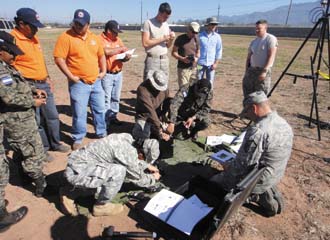 |
Members of the Pre-positioned Expeditionary Kit (PEAK) team provide installation instructions about the communications portion of the system to U.S. and Honduran military personnel as well as representatives from the Comisión Permanente de Contingencias (COPECO), Honduras’ equivalent to the U.S. Federal Emergency Management Agency. The first demonstration of PEAK was performed at Soto Cano Air Base, Honduras. |
Members of the U.S. military community are ensuring that some good comes out of the catastrophic earthquake that hit Haiti in January 2010 by creating a response package that will improve rescue efforts during similar future events. Rather than assembling capabilities that troops can take with them when leaving for humanitarian assistance missions, the new offering will be predeployed and ready for action sooner. In the end, aid should be available more quickly, and U.S. partners should be better equipped to take care of themselves or lend a hand.
Known as Pre-positioned Expeditionary Assistance Kits (PEAKs), the tools fill gaps identified during disaster response activities, including the earthquake that hit Chile about a month after the Haitian devastator, as well as address more overarching concerns. Writers of the Quadrennial Defense Review published in February 2010 identified building the security capacity of partner states—sometimes referred to as building partner capacity—as a mission area growing in importance. PEAK is a first attempt to address U.S. Defense Department capability shortfalls identified in the Quadrennial Defense Review within the building security capacity key mission area. Additionally, in February of this year, the National Military Strategy of the United States of America put forth the call for the joint force to pursue security cooperation and to help strengthen the defense capabilities of allies and regional partners to support and advance U.S. interests.
To that end, the Office of the Secretary of Defense (OSD), National Defense University’s (NDU’s) Center for Technology and National Security Policy and U.S. Southern Command (SOUTHCOM) acted as oversight executive, technical manager and operational manager, respectively, for the PEAK Joint Capability Technology Demonstration (JCTD). The OSD funded the effort, and the command sponsored it. SOUTHCOM also worked with U.S. Pacific Command and U.S. Africa Command on the endeavor, which addresses a specific operational problem within SOUTHCOM: the ability to promote security and enhance stability within its geographic area of responsibility. This ability is constrained by a limited capacity to enable scalable, critical services during time-sensitive events such as disaster relief and some types of law enforcement and peacekeeping.
JCTDs are designed to quickly roll out programs that find, exhibit and transition innovative, operational capabilities to warfighters. PEAK was chosen as such a demonstration in part because it supports objectives to build security capacity of U.S. partners; it is the first demonstration of this type to do so.
Progress on the program did move fast. From starting in March 2010, personnel needed less than one year to move to the testing phase. An operational demonstration, one of the key milestones in a JCTD, was conducted from January 31 to February 11, 2011, at Soto Cano Air Base, Honduras. Carried out in conjunction with Joint Task Force-Bravo (JTF-B) stationed in that country, the test showcased the ability to provide support to team members and system operators, and it demonstrated the utility and initial integration of PEAK’s four component capabilities.
The components PEAK seeks to preposition are designed to help provide sustainable, essential services in efforts with crisis time frames. They are: 1,800 gallons per day of potable water from local sources; power for the entire system primarily drawn from renewable resources; local situational awareness of critical, time-sensitive events for information sharing with decision makers; and local and global communications to transmit and receive voice, data and images. The energy sources used in PEAK combine solar power with a bank of lithium ion batteries.
Elmer L. Roman, the oversight executive for building partnerships in the Rapid Fielding Directorate at the OSD in conjunction with Phil Stockdale, technical manager, PEAK JCTD at NDU, and Lt. Col. John Ferrell, USA, of the J-72, Science, Technology and Experimentation at SOUTHCOM, explains that, “Lessons learned from previous disasters, including the Haiti earthquake, led what would be included in PEAKs. When a disaster event occurs, the biggest problem decision makers have is the information gap [between] what is ‘truly happening on the ground’ versus ‘what the news is reporting.’ This system of systems allows a team to deploy to a crisis area quickly, conduct assessments of the greatest needs and communicate that information to key decision makers to coordinate a more efficient relief effort.
“The renewable energy and water components,” Roman continues, “allow the team to operate independently of the local area resources, so as not to burden already stressed essential services where they may be overly strained or nonexistent. The robust water purification system also allows the team to help local responders meet the needs of the local populace while allowing for sustained operations with a small logistics footprint.”
The portable cell phone network included in the kits supports up to 50 users over a two-mile radius. Information will be compiled in the Tactical Ground Reporting (TiGR) system, a user-friendly, map-based system developed by the Defense Advanced Research Projects Agency. The information can be shared with decision makers and others via included Broadband Global Area Network, or BGAN, satellite connections and narrowband connections to the Internet. Included technology is nonproprietary, reducing the challenge of integrating with local equipment.
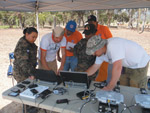 |
PEAK team members train the COPECO and Honduran military on the use of the situational awareness portion of the kit. The system is expected to reach a period of extended use in fiscal year 2012. |
Honduras was selected as the first test site for these capabilities for several reasons. Soto Cano offered a suitable venue and environment to assess PEAK capabilities, and the Honduran government was interested in participating. The country sent representatives from its Military Humanitarian Response and Rescue Units and the Comisión Permanente de Contingencias—Honduras’ Federal Emergency Management Agency equivalent—to evaluate the capabilities alongside JTF-B forces. During the evaluation, the PEAK operational and technical management team members used three disaster-response scenarios to train the various operators on how to use the equipment.
Other reasons for choosing Honduras include the recent events that occurred in the same region of the world that brought attention to the need for this type of system, as well as a desire to promote good will with a U.S. ally. The kits can work for such allies in two ways: to augment U.S. military abilities to support foreign disaster response (FDR) operations immediately after events; and to offer a way for partner states to respond to disasters with precarious timelines on their own.
“So there is a dual role for the kits; [to] increase the capability of U.S. forces and other U.S. government agencies involved in FDR and to build partner capacity in humanitarian assistance/disaster relief” using security assistance funds or other government programs, Roman says. Operational users will include the U.S. military and other agencies, partner nation armed forces and agencies, and nongovernmental organizations (NGOs).
“In order to provide for the rapid delivery of essential services such as water, power from renewable sources, shelter, sanitation, medical, food processing and storage, and reliable communications capabilities during crises, the United States needs cross-cutting, whole-system approaches, integrating multiple technologies to provide or repair essential services during time-sensitive events,” Roman explains. “These capabilities should allow the joint force to improve living conditions in distressed areas while promoting security, stability and economic development in coordination with other U.S. agencies, NGOs and other international partners. Lessons learned from PEAK will help DOD [Department of Defense] to develop a long-term investment strategy to support development of similar capabilities aimed at improving U.S. response to disaster events both abroad as well as at home.”
By assisting partner nations in meeting the needs of their people, especially in crisis situations, the United States helps local governments maintain stability in otherwise fragile situations. This stability leads to better security locally and regionally, which provides for long-term peaceful resolutions of crises, according to the military. As U.S. forces work with partner nations, the groups should be able to develop whole-of-government mechanisms that facilitate the rapid transfer of the types of materiel included in PEAKs to disaster areas to help establish secure and stable environments.
In addition to capabilities that would be sustainable using locally available resources, SOUTHCOM is working with its partner nations to increase situational awareness at lower cost, to provide more in-transit visibility of materials being shipped and to accelerate the transition of critical capabilities to partner nations. The Defense Department is conducting its own work to integrate the capabilities of the joint force with those of the U.S. Agency for International Development, the State Department and other organizations to facilitate the deployment of enduring essential services during times of critical need.
Though primarily designed for peacetime operations, the kits have potential for other situations. Their light mobility, renewable energy and water components could have applications in remote outposts. This would help reduce logistic requirements and therefore expose fewer troops to the dangers associated with moving supplies. Local and global communications components in PEAKs could find employment as backup tools at small bases on the kinetic battlefield. Combatant commands (COCOMs) also might find more uses for the system to meet local needs. One design requirement of the project mandated that the system remain simple to operate and maintain so that joint forces could quickly and easily train local first responders, interagency personnel or NGOs to deploy and use them.
Fielding PEAK as a joint capability rather than through an individual service reflects COCOMs’ involvement. By maintaining PEAKs across the services in a joint manner, the commands will be able to react to situations with flexibility. One of the key concepts for the employment of the kits is to position them near civil support service facilities located within COCOM areas of responsibility, thus allowing leaders the opportunity to determine the best use of the kits for any given contingency.
Moving forward, PEAK will continue to demonstrate and transition an array of capabilities fit for prepositioning to help provide sustainable, essential services to enhance COCOMs’ ability to improve security and enhance stability in their regions. After additional development, testing and demonstration, program officials expect transition and a period of extended use during fiscal year 2012. Upon successful implementation in SOUTHCOM’s part of the globe, PEAK capabilities will be made available for implementation by other COCOMs.
WEB RESOURCES
DASD/RF Rapid Fielding: www.acq.osd.mil/rfd/main.html
NDU Center for Technology and National Security Policy: www.ndu.edu/CTNSP
National Military Strategy of the United States of America: www.jcs.mil//content/files/2011-02/020811084800_2011_NMS_-_08_FEB_2011.pdf
Quadrennial Defense Review: www.defense.gov/qdr/images/QDR_as_of_12Feb10_1000.pdf
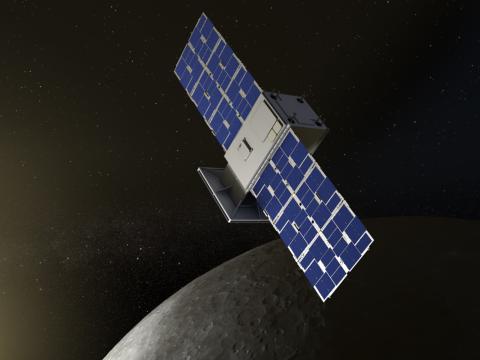


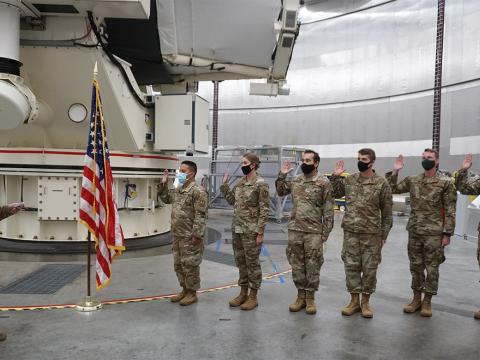
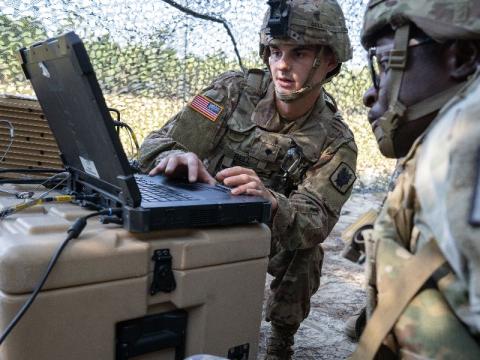
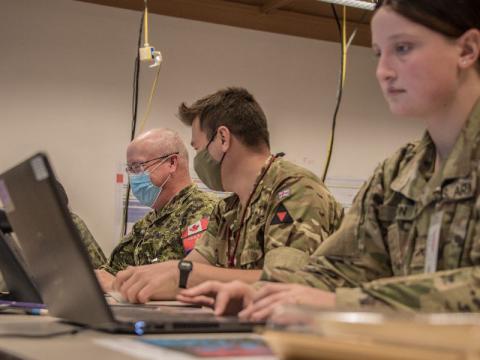
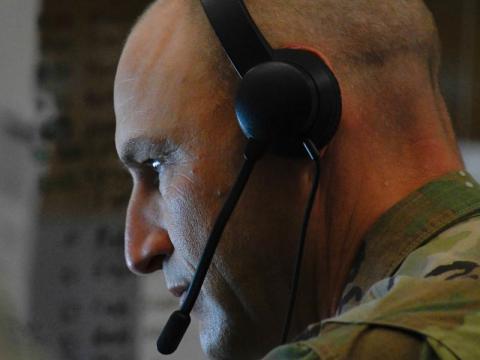
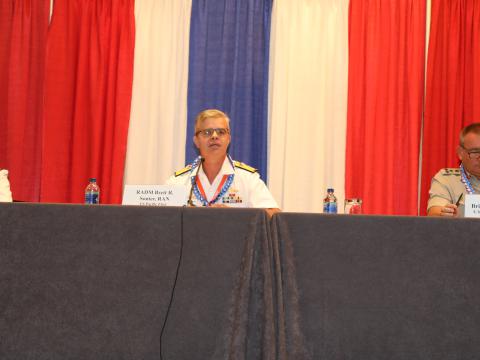

Comments